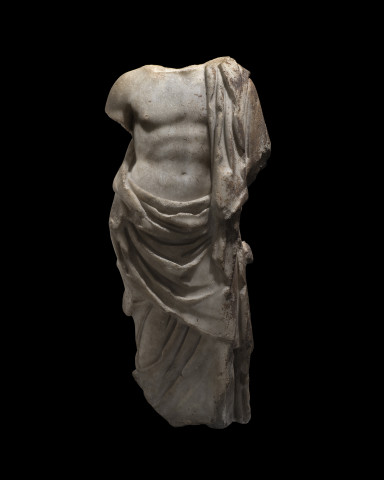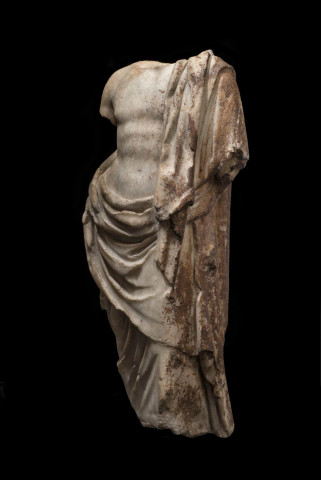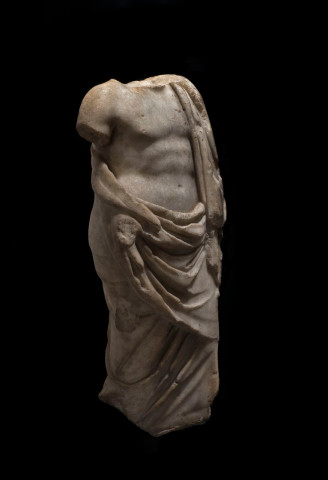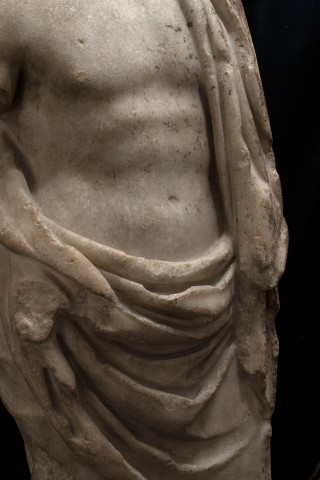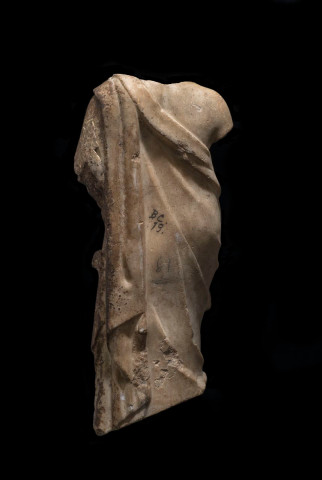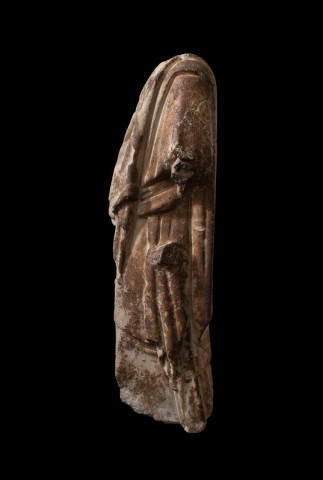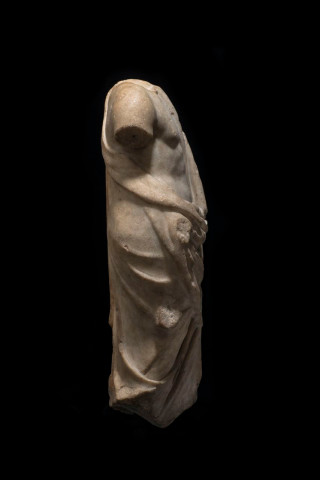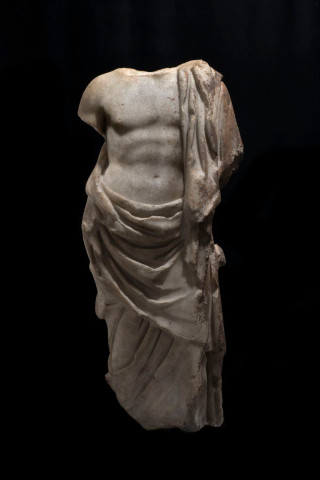Roman statue of Asclepius, c.100-150 AD
Marble
Height: 68cm
10289 EL
£ 195,000
Further images
The god of medicine (Asklepios in Greek) is depicted with a bare chest and well defined musculature, thick drapery wrapped low around his waist and flung forwards over his left...
The god of medicine (Asklepios in Greek) is depicted with a bare chest and well defined musculature, thick drapery wrapped low around his waist and flung forwards over his left shoulder. His back is covered by the drapery which falls in vertical folds from the left shoulder. He stands contrapposto, weight on his right leg, the left knee slightly bent, his hips cocked. The head, feet and arms now missing, some staining and encrustation to the proper left side, the surface with root marks, some areas of damage restored to the drapery on the proper left side.
This type, known as the Campana Asklepios is a Roman copy of a 4th century BC Greek masterpiece. In the original the figure supported his weight on a stick, which had a serpent coiling its way upwards. Asklepios, meaning 'to cut open', was the son of Apollo, reared and educated by the centaur Chiron, the same who taught Achilles. Chiron passed on the wisdom of healing to Asklepios, who soon became the master and started to treat the deceased, bringing them back to life. For this sin Zeus struck him dead with a thunderbolt. After his apotheosis, mankind continued to worship him as the god of healing. The cult of Asklepios started in Epidauros around the 5th century BC. His cult grew over the centuries and spread throughout the Graeco-Roman world. In the 3rd century BC he was one of the first eastern deities to be adopted into Roman state religion, where he was worshipped in both the public and private spheres.
This type, known as the Campana Asklepios is a Roman copy of a 4th century BC Greek masterpiece. In the original the figure supported his weight on a stick, which had a serpent coiling its way upwards. Asklepios, meaning 'to cut open', was the son of Apollo, reared and educated by the centaur Chiron, the same who taught Achilles. Chiron passed on the wisdom of healing to Asklepios, who soon became the master and started to treat the deceased, bringing them back to life. For this sin Zeus struck him dead with a thunderbolt. After his apotheosis, mankind continued to worship him as the god of healing. The cult of Asklepios started in Epidauros around the 5th century BC. His cult grew over the centuries and spread throughout the Graeco-Roman world. In the 3rd century BC he was one of the first eastern deities to be adopted into Roman state religion, where he was worshipped in both the public and private spheres.
Provenance
Jacques Bacri (1911-1965), Paris, France; plundered by the Einsatzstab Reichsleiter Rosenberg (ERR) sometime 1940-1942, then restituted to the family 14th January 1947: https://www.errproject.org/jeudepaume/card_view.php?CardId=3635The Einsatzstab Reichsleiter Rosenberg (ERR), the “Special Task Force” headed by Adolf Hitler’s leading ideologue Alfred Rosenberg, was one of the main Nazi agencies engaged in the plunder of cultural valuables in Nazi-occupied countries during the Second World War. A particularly notorious operation by the ERR was the plunder of art from French Jewish and a number of Belgian Jewish collections from 1940 to 1944 that were brought to the Jeu de Paume building in the Tuileries Gardens in Paris for processing by the ERR Sonderstab Bildende Kunst or “Special Staff for Pictorial Art.” This torso was one such piece.
Exhibitions
Colnaghi, London, UK, curated by Alfred Kren, 'The Decay of Beauty, the Beauty of Decay', 9th October-8th November 2024Literature
Compare an almost identical example in the Museumlandschaft Hessen Kassel, inventory no.Sk 10, and an over life-size example from the collection of Giampietro Campana in Rome, now in the Hermitage Museum, inventory no. ГР-4178Publications
Alfred Kren, The Decay of Beauty, the Beauty of Decay (London, 2024) p.3521
of 21
